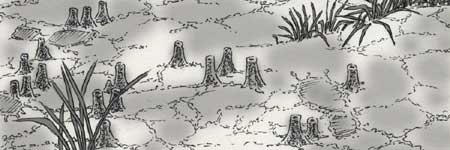
I am a ghost this night, a ghost writer to be more precise, but I don't feel out of place. Ghosts surround me, hundreds of them, thousands, both Japanese and American, all quiet now and sleeping. Overhead, the stars are bright sparks frozen fast in a midnight sky, but the quartering moon is absent, a wanderer somewhere below the horizon. The white path of pulverized coral crunches under my feet, and points a pale finger east toward the immense runway. I step out onto the asphalt. It shows evidence of hard use, long wear, and the final, benign neglect that followed. Weeds and sturdy sword grass are marshaled in a chaos of cracks and angling crevices. The few planes are grey, gloomy shadows in the night. I pass among them on my way to the hardstand where the B-29 is parked. Arriving under a massive wing, I stop and set my recorder down. The hardstand has fared no better than the runway. Anthills rise through the asphalt like the cones of tiny volcanoes. Several are destroyed by the shoes of the busy ground crew, but the destruction passes unnoticed by all save the ants. The crew is already aboard, warming their fifty-five ton monster out of a cold steel slumber. A prop turns, grinding around like a reluctant turnstile. The motor behind it coughs, sputters, then vibrates with muted thunder as it drinks a spray of high-octane fuel. Montez, the radar man, approaches. "Ready to go, Mr. Elliott?" "Guess so." The first prop is a blur now. Beyond it I see the bomber's nose in the light of watery scaffolding lamps. On the ship's side is a colorful, if somewhat faded, insignia: a picture of Donald Duck, his fists raised in fury, and a large bomb under his webbed feet. As I climb in ahead of Montez, a Cyclone on the opposite wing grumbles to life. Ernie Sprigg, my photographer, is already aboard, a small balding Chicagoan always half-hidden by a collection of cameras and lenses. The other passengers are there, too, crowded forward in the giant's long steel gut: Taves, silent and introspective; Jackson, a stoop-shouldered monolith in a VFW uniform; pimple-faced Doran tense with eager excitement; the blonde at his side, a real looker, but shy, and maybe a little embarrassed. Outside, there's more thunder, lots of it, as the four 2200-hp. engines race, testing their power. The ground crew falls back as smoke belches from exhausts. In a moment, we're moving and the thunder is a pulsing roar. We trundle along the taxiway. Brakes squeal and the big bomber turns, jockeys onto the runway. Forty seconds and nine thousand feet away lies a dark road up into the night. Our speed picks up rapidly as our pilot, Colonel Bong, moves the prop control forward into flat pitch. Sound hammers, crashes against the fuselage, and clouds of white coral dust boil away from the spinning prop tips. "Man oh man!" cries Doran, as we begin our run toward heaven and a more distant hell. He jerks a comb back through his duck tail, displacing several ounces of Brylcream in the process. The blonde -- name's Sherry, I think -- looks away from her pimpled fiancé. There's trouble between them, I'm pretty sure, a basic difference in personalities even Doran's money can't quite overcome. I'll keep that in mind. The girl is a looker. And once the flight's over, there'll be time for us to get to know each other better. Nearby, Taves' drooping head conceals his grey eyes, empty of all but a lingering agony. He sees nothing, not even his own wrinkled, weatherbeaten hands. His mind's eye is on that picture he showed me earlier, the one now tucked away in his right breast pocket. Jackson, shifting restlessly in his VFW uniform, chews he butt of an unlit cigar and wishes he could smoke, but inflight, it's not allowed. Ernie is babying his high class Brownies, and the crew is doing the same with their flying dinosaur. Me, I talk to my recorder. Isley Field, with its miles of taxi strips, runways, and hardstands, falls away from us as the Donald Duck labors for altitude. We circle, joining a formation of a hundred droning specters, and climb to eight thousand feet. Saipan, seventy-five square miles bought with Marine and Army blood, lies just below us, a lump of shadow floating on a dark silver sea. The Kagman Peninsula and the Tapotchau Range, razor-edged and honeycombed with caves, are just visible. Lake Susupe is a dull mirror, the nearby swamps a sprawling clot of oily gloom. We fly north and the sea expands below us, spreading wet arms to every horizon. Sixteen hundred miles and seven hours away is Japan, a nation at war with the world. |
|
